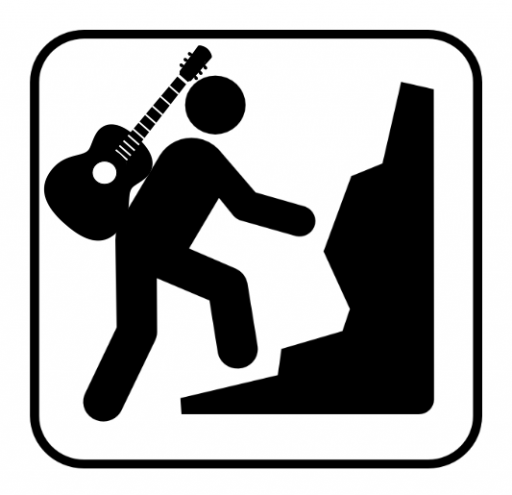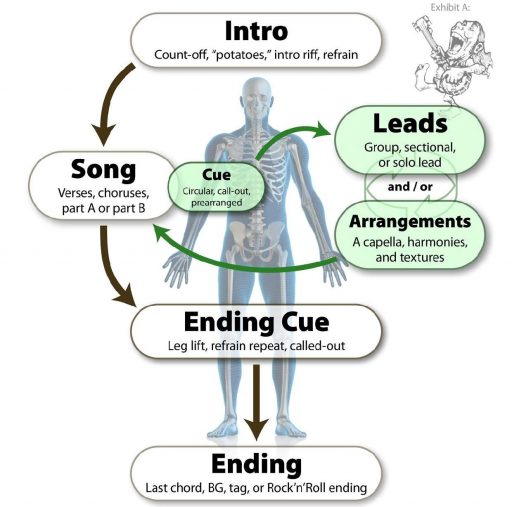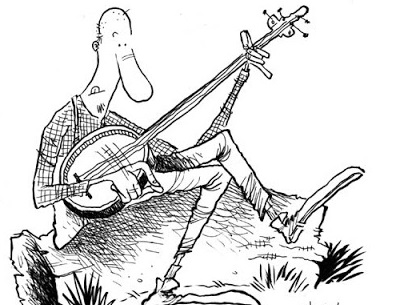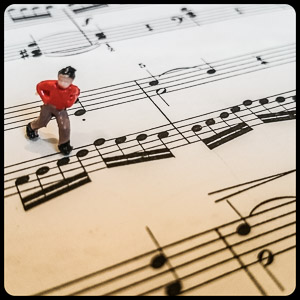The Jammer’s Journey
If we learned to swim like we  learn to jam, we would have one lesson and then be pushed off a cliff into a stormy sea. It’s true. There is a ton of material on how to operate your given instrument, and then plenty of chances to attempt what you learned in a group setting and watch it fly to pieces, raining down burning shards of your expectations.
learn to jam, we would have one lesson and then be pushed off a cliff into a stormy sea. It’s true. There is a ton of material on how to operate your given instrument, and then plenty of chances to attempt what you learned in a group setting and watch it fly to pieces, raining down burning shards of your expectations.
And that’s one of the primary motives for our study of jamming, is to get a clearer picture on where we are in our jamming abilities, as well as set goals so that each jam becomes a learning experience for us. In other words, there is a big difference between showing up and struggling to get through the chords to a song, or being able to have fun while playing them and add your own licks and tricks. But the question is, what exactly is this difference?
Well, beside simply countless hours of practice time (and that doesn’t sound terrifically fun) the secret is this: having a clear map for your progress in the art of jamming, and knowing where you are on that map.
We have such a map, designed specifically for those of you starting out on the path of jamming, and we call it the Jammer’s Journey.
It will take you from those first mind-numbing experiences when you attend your first jams, and end up clinging on to any chord you can find and praying for the tune to be over with, to the full realization of Jam Guru, where you are hosting and leading your own pickin sessions, and are hopelessly hooked on this delightful pastime.
Let’s look at what this entails…
Stop, Children, What’s That Sound – “Nada Yoga” and Conscious Listening
The idea th at sound is an essential part of the universe, and of our very self awareness, is not new. Humans were in fact fashioning musical instruments as far back as Paleolithic era, as evidenced by the discovery of bone flutes in southern Germany that are over 40,000 years old. Yes, we humans have been fascinated with sound and music making for quite some time.
at sound is an essential part of the universe, and of our very self awareness, is not new. Humans were in fact fashioning musical instruments as far back as Paleolithic era, as evidenced by the discovery of bone flutes in southern Germany that are over 40,000 years old. Yes, we humans have been fascinated with sound and music making for quite some time.
One of the oldest traditions involving the mystical nature of sound is Nada Yoga, an Indian metaphysical system teaching that the entire cosmos, including human beings, consists of sound vibrations, called “nāda”. These teachings are found in the Rig Veda, an ancient religious text going back three-and-a-half thousand years.
As is often the case, it is fascinating to note that modern quantum physics is now echoing this same view, centuries after the yogis first observed it. Much of how quantum physics describes our world could be boiled down to “at it’s core everything is simply vibrating energy fields”. Once again, science has finally caught up with mysticism!
What is even more fascinating about Nada yoga is that its practitioners were taught to listen to these “quantum” sounds, by learning to tune in and listen to the internal world.
We Don’t Strum It Till You Order It
I’ve been teaching music for quite some time now, and although there have been highs and lows and challenges of all sorts, there has always been one beacon of consistency: I was teaching what I knew! In other words, I knew each student fairly well and made a point of preparing for each lesson so I could be confidant that every student was getting what they needed. Lesson prep was my savior, and having songs ready to go made the sessions run smoothly. And yes, there was a certain sense of control there too, after all I was essentially creating the curriculum and setting the course for each of my underlings. Sure I would gladly take suggestions and always encouraged students to pick songs, but in general folks seemed to like being led along, and so it went.
All that changed when I began the Custom eLesson program with JamAlong.org. It all started with a caffeinated conversation with some of my music teacher pals while hanging out at Old Towne Coffee.
Practice Makes Perilous
It seems that most folks learning a new hobby find numerous ways to make the process more difficult.
I was no different. Not long after I had mastered the “baby steps” of the banjo, I made the dubious decision to tackle harpsichord music from 17th century composer J.S. Bach. I’ve never been able to explain exactly why, but for some reason the labyrinthine complexity of Bach’s melodies fascinated me.
So of course I had to learn them on the banjo.
Now this was no small feat. First of all the range of the harpsichord was four times that of the banjo, and, there were completely separate parts for each hand. But I stubbornly invented fingerings measure by measure, even though many parts were physically impossible.
Teeth clenched, sweat beaded on my brow, I would hurl myself against the music over and over again. One particular phrase giving me grief was a five fret stretch somewhere around the 11th fret, during one of Bach’s many key changes.
Eventually I realized there was no humane way to play this section. But instead of abandoning ship and finding another project like any reasonable person would have done, I battled onward.
Anatomy of a Jam

Everybody wants to jam, but nobody wants to sound bad. Yep, and that’s where the rubber meets the road for beginners, or even folks who have played for quite a while, but perhaps in classical music or other solo styles that don’t place a big emphasis on jamming. It’s one thing to play Malaguena or Stairway to Heaven perfectly for your cat, it’s another thing entirely to pull off the same performance in a circle of ten other strummers! And as anyone has discovered who has dove into a jam session for the first time, it’s kind of like jumping into a washing machine. You start out OK, but then the next thing you know you’re upside down and backwards, and have a hard time knowing what chord everyone is on, or even if you’re in time with the rest of the group. It’s often chaos, pure and simple.
So how to reduce the amount of trauma for those just starting out, the ones who decided “oh what the heck, I’ll go down to the cafe and see what this jamming thing is all about!”, or brought their banjo to a bluegrass festival and then found themselves surrounded by inebriated strummers who stumbled into their camp and engaged in a full on sing-along. What to do, what to do?
Beginners Blues – ½ dozen issues every learner faces
 As it is with many hobbies, there is a learning curve when we first begin (or are beginning again). This “curve” is filled with all sorts of obstacles to our sticking with it and many quit during this phase. Although there is nothing that can replace “stick-to-it-iveness” and patience, having some knowledge ahead of time can save you a lot of grief. So, before we even pick up our first drum or sing a scale, let’s learn about the bumps in the road that may lay ahead…
As it is with many hobbies, there is a learning curve when we first begin (or are beginning again). This “curve” is filled with all sorts of obstacles to our sticking with it and many quit during this phase. Although there is nothing that can replace “stick-to-it-iveness” and patience, having some knowledge ahead of time can save you a lot of grief. So, before we even pick up our first drum or sing a scale, let’s learn about the bumps in the road that may lay ahead…
Although everyone’s learning journey is uniquely their own, there are some common patterns which most of us will experience as we dive into the learning (or re-learning) process. Here then are a half dozen of the more common issues you will likely encounter, as well as a suggested solution for each. I don’t offer “the” solution because there is no one solution, and you will discover your own as well. It is helpful to get out a journal here and write down your own issues and solutions (and be sure to add them in the comments below, we LOVE to hear from readers!)
Take This Job and ……(Why I teach Music)
Why do I teach music? Well, for one, I have no other job skills. I mean, it’s not like I didn’t try. In fact, I tried as soon as I moved out and got my own place, and the next day walked into every business on my block filling out applications.
The next day my roommate said “dude, just apply at a fast food place, they’ll hire anybody”.
So I applied at Kentucky Fried Chicken, and got hired the next day. The manager was a rosy faced over-achiever with too much mousse in his thinning hair.
“I knew exactly what job you would be great at, the minute I talked to you..” he enthused, leaning toward me across his cluttered desk. “We’re going to put YOU, on the Assembly line!”
The Dangerous Bridge – How To Practice Taking Leads With Tactical Practicing
Often in life the hardest things are the transitions. Sure, ice skating is hard, and rocket science is probably no picnic. But I am sure if you interviewed Nancy Kerrigan or Dr Robert Goddard, they would both agree that it was harder when they were getting started. Once you’re in the groove, things generally go your way, but getting up on that cold gleaming ice without face planting, that’s another story.
And it’s the same with playing music. As anyone knows who’s played an open mic, once you were walking off stage with that smattering of applause swirling around you, life was grand. But when you were waiting in the green room to go on, someone could have said “boo” and you’d have jumped out of your skin! But eventually you stumbled up there, and after a few terrifying moments that lasted an eternity, you launched your song and managed to get through it without any unintentional urination.
Music Versus Gobbledygook – Music “theory” demystified
 As Daniel Levitin, author of This Is Your Brain On Music says, “It’s a shame that many people are intimidated by the jargon musicians, music theorists, and cognitive scientists throw around.”
As Daniel Levitin, author of This Is Your Brain On Music says, “It’s a shame that many people are intimidated by the jargon musicians, music theorists, and cognitive scientists throw around.”
All arts have this problem: the divide between the creation, and the description of the creation. Imagine the experience of gazing at the painting of the Mona Lisa, relishing the soft amber tints and her mercurial smile. And then imagine your experience of attending a lecture on the history of the painting as well as the chemical makeup of the canvas and paints used, in excruciating detail.
It’s the same with music. You can enjoy music washing over you without needing any technical knowledge at all of what key it may be in, or time signature or even who wrote it. And furthermore, you can MAKE MUSIC without any technical knowledge!
But, to understand the enemy is to be better armed, so lets dive into just a tiny bit of “music theory”, or as I like to call it, gobbledygook 🙂
Music makes your brain grow!
Music is truly one of few activities that employs all of our brain at the same time. As musician and neuroscientist Daniel Levitin puts it: “Musical activity involves nearly every region of the brain that we know about.”
If you know even a little about brain science, you know that this is a big statement.
Complex behaviors such as walking, talking and making plans have general locations in our brain assigned to these actions. For example our “frontal lobes” handle our daily planning, and hearing what’s going on around us. And remembering all of this is the responsibility of our “temporal lobes”. Meanwhile, our “cerebellum” (or brainstem, which is the most ancient part of our noggins) keeps us moving and feeling.
Please note that these concepts come from a field of science that is murky and ever evolving, and the brain is much more mysterious and interconnected than these theories suggest, but it does appear that different parts of our brains light up when we do different things (according to the neuroscientists).
However, when we encounter music, it has been shown that our entire brain lights up; all one hundred billion neurons!